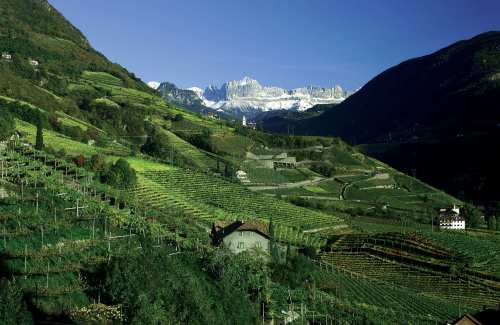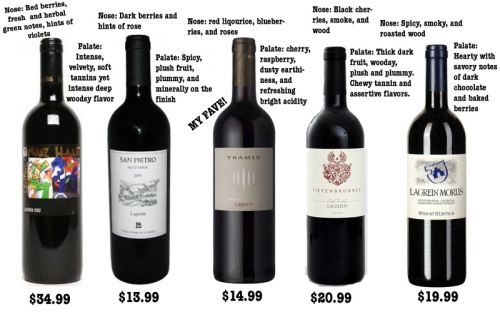Weird indigenous grapes from Italy have been showing up on NYC wine lists like its their job. It started with Lagrein– a rare grape indigenous to Italy’s Alto Adige region. Next, it was Pelavergo– a grape I’d never heard of from Piedmonte in Northwest Italy. Then Gaglioppo started to pop its strange little head up from time to time, this time an indigenous grape from Calabria – at the other end of Italy’s boot. Now, I’m spotting Freisa –another obscure indigenous grape from Piedmonte – on menus here and there. Freisa, in fact, is one of the most derisive grapes in the wine world that drinkers either adore or vilify (it has been praised as “immensely appetizing” and derided as “totally repugnant” in the media).
Like I said, Lagrein is a weird grape that has been showing up on wine lists across the city in the last few months. Not surprisingly, given its sturdy character, I first noticed it in the dead of winter. I’m always intrigued by multiple sightings of a grape I’ve never heard of within a short period of time. I like to think that I’m pretty geeky when it comes to wine and it’s hard to get one by me (see above). So when I saw Lagrein listed on three different lists within a month, I was determined to find out what this wine was and what exactly everyone else had already figured out.
First off, Lagrein is indigenous (and pretty much exclusive) to Alto Adige – a region that comprises part of the Northeast corner of Italy. It’s a region that straddles the borders of Austria and Switzerland and is very mountainous – covering a large swath of the Dolomites and the Southern Alps. In short, it’s very cold and a majority of the region has a pretty significant elevation.

Image via John Mariani @ Cork Dork
The region is also known as Trentino-Alto Adige and Sudtriol. It’s a region that, wine-wise, is best known for Pinot Grigio and Pinot Noir. Knowing all of this, I was poised to expect a red that reflected its chilly upbringing – something light, floral, brisk, and maybe medium-bodied at its heaviest.
Lagrein, however, fits none of those descriptions – in fact, I’d even go so far as to say that this grape makes a wine that is hearty. Not rich or luxurious – this is no Napa Cab – it’s a little rough around the edges and not a wine I’d characterize as “refined” – but no less charming for it. The hearty character of the wine means it goes well with a soul-warming stew, braised or grilled meat because it’s got a fair amount of tannin to suck up all that fat– exactly the kind of warming-up wine that you might want to drink if you were snowed in by a blizzard raging in the Alps.
Eric Asimov, the NYT wine critic, must have noticed Lagrein’s steady rise in popularity, too – he wrote in a March 28 column about this wine that is was “deliciously plummy, earthy and chewy, dark and full-bodied but not heavy, with a pronounced minerally edge”. He also mentioned that the wines had a savory side (I’d call it gamey), floral notes, and bright acidity.
Of the five Lagriens that I’ve sampled over the past few months, all but one fell definitively in the plummy, chewy, dark, and full-bodied side of the spectrum and I had a hard time detecting this fabled bright acidity.
The Lagreins that I tasted, too, had a pronounced savory quality, and the notion of darkness in a wine is something you can taste in a Lagrein. And as Asimov wrote, the tannins in Lagrein are chewy rather than sturdy – something that I had a hard time with. I tended to agree with one of the members of the NYT tasting panel that the wines I tasted lacked sufficient structure and usually hit one or two notes strongly and then collapsed.
This is not to say that I didn’t enjoy these wines – because I did. And in particular, I enjoyed the one Lagrein that stood out from the rest because of its brightness, refreshing floral character, and tight structure. In fact, the Lagrein that I liked best approached the freshness and structure of a young wine from Ribera del Duero, but with richer and darker fruit, a streak of gamey earthiness, and compact tannins to hold the whole thing together. It was also the cheapest of the Lagreins I tried at about $16.99 – the Cantina Tramin Lagrein 2011.
Especially with Memorial Day right around the corner, heralding the unofficial start of grilling season, Lagrein is a wine to keep in mind. With dark plummy fruit and a soft chewy mouthfeel, Lagreins are a wonderful barbecue wine. For the drinker tired of resorting to California Cabs or a bottle of room-temp Merlot, Lagrein is an interesting and novel choice for accompanying grilled meats. The thick dark fruits will appeal to the untrained palate, but the eyebrow-raising texture and healthy tannins will please the drinker who knows what to look for in a wine served with steak.
See below for more info on the Lagreins pictured above!
Franz Haas Lagrein ($34.99)
Tiefenbrunner Lagrein “Turmhof” 2010 ($19.99)
H. Lentsch Lagrein “Marus” 2009 ($24.99)
Cantina Tramin Lagrein 2010 ($16.99)
San Pietro Lagrein 2009 ($14.99)
*The Lagreins reviewed were sent as samples.



Leave a comment